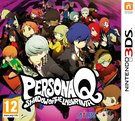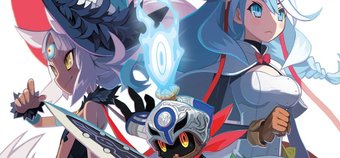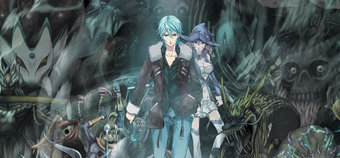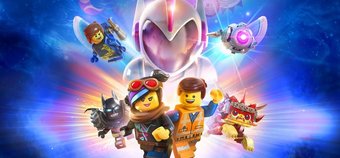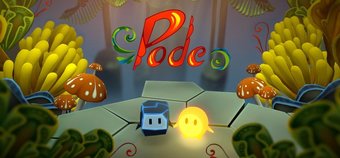Some things in life just go well together. Sausages and mashed potato, garlic and bread, peanut butter and Marmite sandwiches (or maybe that's just us) - and now Persona and Etrian Odyssey. The first game in the award-winning role-playing-game-come-life-simulation hybrid Persona series to come to a Nintendo console, Persona Q mixes the characters and worlds from the game's most popular instalments - Persona 3 and Persona 4 - with the hardcore dungeon crawling of the much more niche Etrian Odyssey series. And it's a mix that works really, really well.
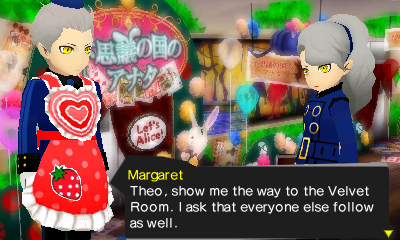
Nice apron, Theo...
It all begins on the day of Yasogami High School's culture festival, when a mysterious bell tolls from somewhere unknown. Rumour has it that an old clock tower used to sit in the school yard, and that whoever heard the chime would die a grisly death - although, with no bell tower in sight, it's appears to be nothing more than a story. Until, that is, a mysterious labyrinth appears in the school on the very same day, filled with evil shadows that feast on people's souls - and the doors to the school have all become mysteriously locked. There's no way out. As the ringing continues, it draws two groups of students from different dimensions together, hoping to solve the mystery of the clock tower and the labyrinths, and recover the memories of two mysterious figures they meet inside.
Persona Q begins with a choice - a choice of protagonist. Mixing characters from two of the earlier Persona games together, you get to choose which game's cast you want to follow. The Persona 3 crowd fight shadowy enemies in a tower called the Tartarus during a hidden time after midnight, known as the 'dark hour', by drawing on the internal strength they get from shooting themselves in the head (makes sense, right?). The Persona 4 guys, meanwhile, are in search of a serial killer with a difference - one who throws his victims into a warped TV world, leaving them to face their worst fears and deepest held secrets head-on in a grisly showdown to the death. Depending on whose stories you follow, you'll have slightly different take on the game's plot, and a different party with which to explore the first dungeon (after which point the two parties meet up, and you get a choice of a whopping 17 people to take adventuring).
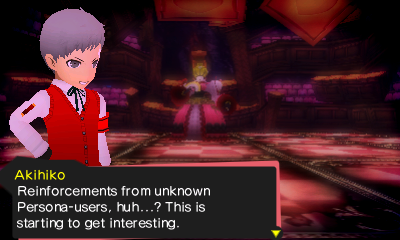
The Queen of Hearts will never know what hit her.
Persona Q itself is essentially a dungeon crawler - and a rather hardcore one at that. Coming with five different difficulty settings, choosing anything from 'Normal' upwards is likely to be signing your own death warrant, with the top difficulty, the appropriately named 'Risky' giving you one life, and one life only, in which to finish the game - no continues, and no revives. 'Easy' and 'Safety' meanwhile tone things down enough that you can mostly just sit back and enjoy the story and exploration, without worrying too much about level grinding.
With a first person view of the dungeon itself on the top screen, and an initially mostly empty screen on the bottom, exploring here is key, and knowing your surroundings can mean the difference between life and death. While most games give you a map to follow, or at least fill one in as you explore, Persona Q takes a slightly different approach, and gets you to make your own from scratch. While it automatically greys in squares you've walked over, budding cartographers will need to draw in the walls, doors and such themselves on the 3DS' Touch Screen. What initially seems like a bit of a daunting concept - given that we can't follow a map at the best of times - actually turned out to be pretty fun, and we soon found ourselves happily colour coding floor tiles, secret passages, enemy movements and potential traps/spikes, combing every square of every floor until the 'percentage explored' counter in the top corner reached 100%. We're not OCD at all. Honest.
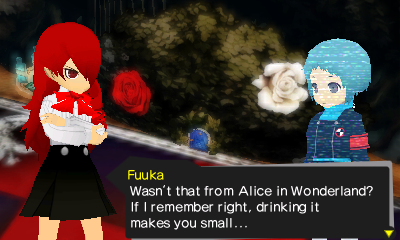
And you'd need to be small to fit through that teeny tiny door...
As a bit of a distraction from the obsessive map-making, Persona Q also throws random battles at you as you explore. In traditional turn-based style, these encounters see you and your enemies - demonic creatures, red-faced baby cupids, and rather angry rocks to name but a few - taking it in turns to attack, use magic or items. Your team members, split into two rows, one behind the other, each have their own strengths and weaknesses in battle, with some folks, such as the robotic Aigis, preferring to shoot from the back row, while meat-loving Chie works best on the front row, where she can kick enemies much easier. Each character, friend or foe, also has their own elemental strengths and weaknesses, which can be used to your advantage in battle - attack an enemy with an element they're weak to and you'll not only do extra damage, but the attacking party member will also enter a special 'boost' state. When boosted, your special moves have no cost, and you'll always move before everyone else - and exploiting this as much as you can is the key to winning battles.
Of course, it wouldn't be a Persona game without some involvement from the titular Personas - special 'beings' that are the embodiment of a characters' psyche. Each is proficient in different abilities, whether it's ice and healing spells, one hit kill life and dark elemental attacks or a particularly vicious stab with a weapon - although using each Persona ability comes at a cost. 'Magic' attacks, whether they're healing spells, buffs or fireballs, cost SP (effectively magic points) - but physical attacks, which come in Stab, Bash and Cut flavours, require a chunk of your health instead. Each character has their own unique Persona that acts as their main source of attacks and special moves - beyond your generic attack, every move you do will be performed using your Persona, which unlocks new skills as it grows in levels through battles. Each character can also equip a secondary, changeable 'Sub-Persona' for additional attacks and stat boosts too.
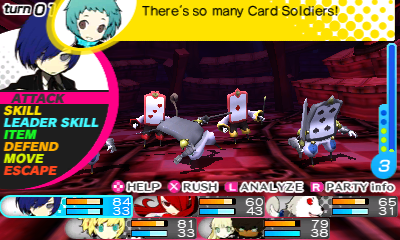
And that's just the first wave...
As you defeat enemies in battle, you have a chance of receiving a tarot card of one of these sub-personas, which can then be equipped on a party member of your choice. As with their default personas, these sub-types can earn new spells and abilities as they gain experience in battle - although unlike the main personas, this only happens up to a point, as after a certain level, they'll stop learning new stuff. This is where the series staple Persona Fusion comes in - by combining two or three personas, you can create new, more powerful ones, learning new and improved skills as you go. Created personas can also inherit abilities from their parents, letting you customise them somewhat and make up for your party's elemental shortfalls.
Dungeon designs are also pretty nifty - bright and colourful, and each with their own distinct theme, from Alice In Wonderland to a warped valentine-esque one, pink and filled with teddy bears and cupids. Of course, it wouldn't be a dungeon crawler without some perils and traps to keep you on your toes, such as spikes that sap SP or arrows that confuse your character's movement when they hit. It's also worth noting that the game is designed in such a way as to make it so you have to keep chipping away at the dungeons, rather than finish them back to back - your character's health and SP are in no way plentiful enough for you to last through. Your best bet is to stock up on Goho-M items (say it out loud) from the store before you venture down into the dungeons, as these let you teleport back to base in an instant.
And then there's the FOEs. A terrifying trademark of the Etrian Odyssey series, FOEs are larger, more powerful boss-type monsters that roam around the dungeons. While battles in Persona Q are random, these guys are visible on your map from the outset - so you can avoid them. Far, far harder than the mandatory story bosses you meet at the end of each dungeon, a FOE can easily wipe out an unprepared party in a few moves, so your best plan of attack is to give them a wide berth, or run like hell should you accidentally start something with one. Often, these FOEs are intrinsically linked to the dungeons, and by solving a puzzle in the dungeon, mapping out their paths, or altering them by interacting with the scenery, you can usually slip by safely.
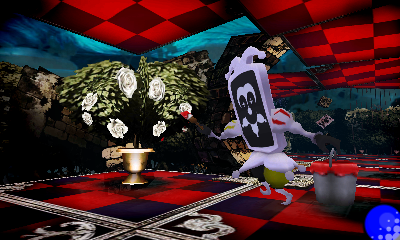
You'll need to avoid this guy at all costs. Fortunately, you can distract him with a rose bush.
But the real highlight is Persona Q's characters and story. With the parties from both Persona 3 and Persona 4 colliding in one game, joined by the mysterious Rei and Zen from the labyrinth world, there's a whopping 18 characters on board - and when coupled with the mysterious, and at times slightly sinister, story, there's rarely a dull moment. High school high jinks, quips and jokes keep things entertaining, whether it's Chie's fiery temper and insatiable appetite for meat, the question mark over tough-guy-biker-but-secret cute-things lover Kanji's sexuality or Teddie hitting on every female in the party (and subsequently being rejected),everyone is true to their original characters, albeit in a slightly exaggerated way. And while the references are likely to appeal most to existing Persona fans, you don't have to have played them to understand, thankfully. Although we highly recommend you do if you get a chance, because they're seriously awesome.

He may look tough, but Kanji has a real weakness for anything cute and fluffy.
If we're honest, we weren't expecting to like Persona Q: Shadow of the Labyrinth. Given our morbid fear of anything remotely difficult, and Etrian Odyssey's reputation for being as hard-as-nails, we were expecting to take to it like a chocolate teapot takes to boiling water. But in actuality, once we'd cranked it down to Easy/Safety, the lively characters and story, coupled with it's interesting make-your-own-map mechanic, made it easily one of the best role-playing games we've played all year.
Format Reviewed: Nintendo 3DS


